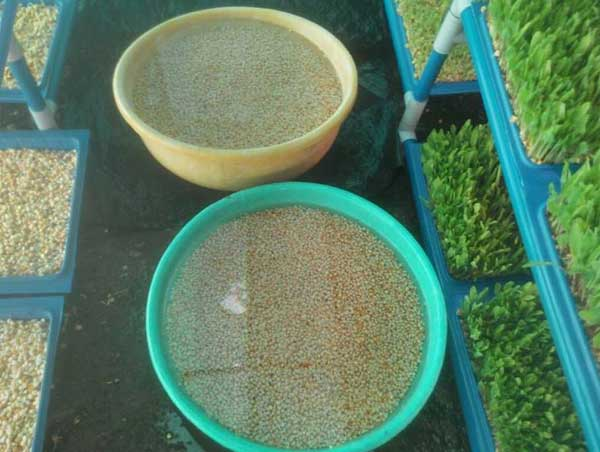HYDROPONIC FODDER
1/7 🌱 What is hydroponic fodder? It's a sustainable and soil-less method of growing nutritious fodder for livestock. Seeds like barley, maize, and wheat are sprouted in a controlled environment using water and minimal resources.
#Thread



1/7 🌱 What is hydroponic fodder? It's a sustainable and soil-less method of growing nutritious fodder for livestock. Seeds like barley, maize, and wheat are sprouted in a controlled environment using water and minimal resources.
#Thread




2/7 🌱 How to grow hydroponic fodder?
a) Soak the seeds for 12-24 hours
b) Spread them evenly in trays/ racks or containers.
c) Rinse the seeds 2-3 times a day to maintain moisture
d) Provide proper lighting and temperature (around 70°F)
e) Harvest the fodder just in 7-10 days.

a) Soak the seeds for 12-24 hours
b) Spread them evenly in trays/ racks or containers.
c) Rinse the seeds 2-3 times a day to maintain moisture
d) Provide proper lighting and temperature (around 70°F)
e) Harvest the fodder just in 7-10 days.


3/7 🐄🐓 What livestock can be fed with hydroponic fodder?
It's suitable for cattle, goats, sheep, poultry, etc. They relish its succulent texture and highly palatable nature.


It's suitable for cattle, goats, sheep, poultry, etc. They relish its succulent texture and highly palatable nature.



4/7 🌿 When to harvest hydroponic fodder?
Once the shoots reach a height of 6-8 inches(15-20.5 cm), they're ready for harvest. This ensures optimal nutrient content and digestibility.

Once the shoots reach a height of 6-8 inches(15-20.5 cm), they're ready for harvest. This ensures optimal nutrient content and digestibility.


5/7 🥛🥚 Health benefits of hydroponic fodder:
- Abundant in vitamins, minerals, and enzymes.
- Promotes better digestion and nutrient absorption.
- Enhances overall animal health and immunity.
- Boosts productivity, leading to higher milk and egg quality.
- Abundant in vitamins, minerals, and enzymes.
- Promotes better digestion and nutrient absorption.
- Enhances overall animal health and immunity.
- Boosts productivity, leading to higher milk and egg quality.
6/7 🌾 Nutrient composition of hydroponic fodder:
- High protein content for muscle development.
- Rich in fiber, aiding digestion and preventing digestive disorders.
- Provides essential minerals like calcium, phosphorus, and magnesium.
- High protein content for muscle development.
- Rich in fiber, aiding digestion and preventing digestive disorders.
- Provides essential minerals like calcium, phosphorus, and magnesium.
7/7 🌱Precautions for hydroponic techniques
1. Seed treated with pesticides and fungicides should not be used for cultivation.
2. The water should be replaced every 3 days to reduce microbial contamination.
3. Clean for fungal growth prevention
4. Use quality seeds
1. Seed treated with pesticides and fungicides should not be used for cultivation.
2. The water should be replaced every 3 days to reduce microbial contamination.
3. Clean for fungal growth prevention
4. Use quality seeds
Embrace the power of hydroponic fodder! It reduces reliance on traditional feed sources, conserves water, and thrives in limited spaces. It's a game-changer for sustainable livestock farming. #HydroponicFodder #LivestockNutrition #sustainablefarming
• • •
Missing some Tweet in this thread? You can try to
force a refresh

 Read on Twitter
Read on Twitter





















